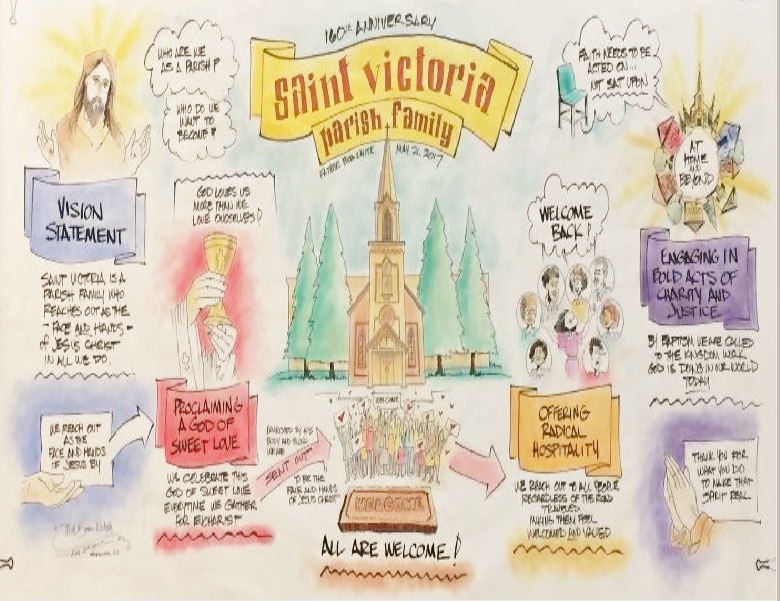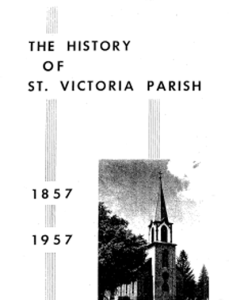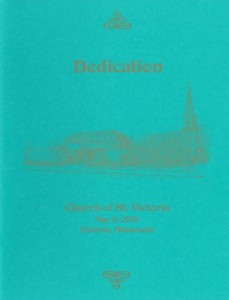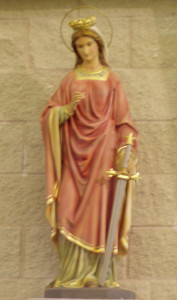History of St. Victoria Catholic Church
St. Victoria was established as a parish in 1857 by our early pioneers and shortly thereafter a small wooden church was built. They chose Saint Victoria as the patron saint of this church as she was a favorite saint from their homeland. Throughout the early years European immigrants flocked to this area in large numbers and found not only a land rich in resources, but for many a new found freedom for their faith. As the population increased in the area a larger church was built of brick in 1870, which is the historic church that you still see today. In 1857 there were perhaps 32 Catholic households in Victoria.
By its centennial in 1957, there were 196 registered homes. In the decades since the area has continued to grow. So once again, construction commenced in May of 2003 on another larger worship space which today is the new church that you see complementing the historic church. The desired goal of that project was attained by preserving our rich heritage while at the same time creating a welcoming spirit for all of the new parishioners moving into the area. In 2007, our sesquicentennial year, we celebrated the 150th Anniversary of the founding of St. Victoria Catholic Church. As of September 1, 2018, there are now 1,428 registered households and counting.
St. Victoria’s community of faith cultivates more than 60 volunteer ministries which focus on reaching out to others as the face and hands of Jesus. Christ calls us to be his body, his heart, his compassion, his forgiveness, to each other and to the world. We do so by proclaiming a God of sweet love, inviting radical hospitality and engaging in bold acts of charity and justice. These are the words of God made flesh in us, His people. Taken together and acted on, they create the vision and excitement for faith to come alive with meaning and joy as we spread the Good News.
As it has been and will continue to be, the richness of its land, people and faith continues to draw many from near and far to gather at St. Victoria. As we step forward on this journey of faith we know that God, the giver of all good gifts, will bless our work.






 “The valueless passio of St. Anatolia relates that when she refused, in consequence of a vision, to accept her suitor Aurelius he went to her sister, Victoria, and asked her to persuade Anatolia to marry him. Victoria’s efforts were not only unsuccessful, but she herself was converted to her sister’s views and broke off her own betrothal with one Eugenius. The young men then removed the maidens from Rome to their respective country villas and tried to starve them into a different frame of mind. Anatolia was denounced as a Christian, and her end is thus summarized in the roman Martyrology on July 9: ‘After she had healed many throughout the province of Picenum who were suffering from various diseases and had brought them to believe in Christ, she was afflicted with several punishments by order of the juge Faustinian; and after she had been freed from a serpent that was set upon her and had converted [the executioner] Audax to the faith, lifting up her hands in prayer, she was pierced with a sword.’ Victoria met with a similar fate, perhaps at Tribulano in the Sabine hills. ‘She refused to either marry Eugenius or to sacrifice and, after working many miracles whereby numerous maidens were gathered to God, she was smitten to the heart by the executioner’s sword at the request of her betrothed.’ Both St. Anatolia and St. Victoria had a cultus in various parts of Italy, but the real circumstances of their martyrdom are not known.”
“The valueless passio of St. Anatolia relates that when she refused, in consequence of a vision, to accept her suitor Aurelius he went to her sister, Victoria, and asked her to persuade Anatolia to marry him. Victoria’s efforts were not only unsuccessful, but she herself was converted to her sister’s views and broke off her own betrothal with one Eugenius. The young men then removed the maidens from Rome to their respective country villas and tried to starve them into a different frame of mind. Anatolia was denounced as a Christian, and her end is thus summarized in the roman Martyrology on July 9: ‘After she had healed many throughout the province of Picenum who were suffering from various diseases and had brought them to believe in Christ, she was afflicted with several punishments by order of the juge Faustinian; and after she had been freed from a serpent that was set upon her and had converted [the executioner] Audax to the faith, lifting up her hands in prayer, she was pierced with a sword.’ Victoria met with a similar fate, perhaps at Tribulano in the Sabine hills. ‘She refused to either marry Eugenius or to sacrifice and, after working many miracles whereby numerous maidens were gathered to God, she was smitten to the heart by the executioner’s sword at the request of her betrothed.’ Both St. Anatolia and St. Victoria had a cultus in various parts of Italy, but the real circumstances of their martyrdom are not known.”